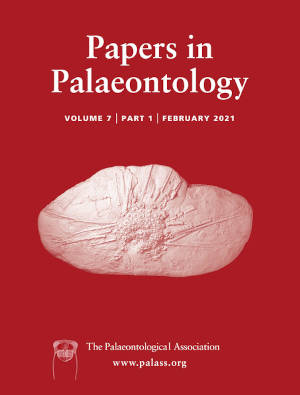Reg. Charity No. 1168330

The extraordinary window of phosphatized and phosphatic small shelly fossils (SSF) during the early and middle Cambrian is an important testament to the radiation of biomineralizing metazoans. While SSF are well known from most Cambrian palaeocontinents during this time interval, western Laurentia has relatively few SSF faunas. Here we describe a diverse SSF fauna from the early Cambrian (Stages 3–4) Mural Formation at three localities in Alberta and British Columbia, Canada, complemented by carbon isotope measurements to aid in a potential future bio-chemostratigraphic framework. The fauna expands the recorded SSF assemblage diversity in western Laurentia and includes several brachiopods, four bradoriids, three chancelloriids, two hyoliths, a tommotiid and a helcionellid mollusc as well as echinoderm ossicles and specimens of Microdictyon, Volborthella and Hyolithellus. New taxa include the tommotiid genus Canadiella gen. nov., the new bradoriid species Hipponicharion perforata sp. nov. and Pseudobeyrichona taurata sp. nov. Compared with contemporaneous faunas from western Laurentia, the fauna is relatively diverse, particularly in taxa with originally phosphatic shells, which appear to be associated with archaeocyathid build-ups. This suggests that the generally low faunal diversity in western Laurentia may be at least partly a consequence of poor sampling of suitable archaeocyathan reef environments. In addition, the tommotiid Canadiella filigrana appears to be of biostratigraphical significance in Cambrian Stage 3 strata of western Laurentia, and the unexpected high diversity of bradoriid arthropods in the fauna also suggests that this group may prove useful for biostratigraphical resolution in the region.
AcknowledgementsWe thank Jen Wasylyk at Parks Canada for permissions and logistical help, and the pilots of the Yellowhead helicopters for safe flying. We gratefully acknowledge support by the National Geographic Society's Global Exploration Fund – Northern Europe GEFNE113-14, NSF grant EAR-1324095, which helped finance fieldwork, and NSF grant DEB-1747731 for support to EAS. This expedition was conceived at a workshop at the University of Bristol with funds from the Dean's Black Swan fund to JV. We thank Kevin Taylor and Amber Shipley of Bearpaw Heli-Skiing for logistical help during Dezaiko fieldwork. Laboratory preparation of SSF samples was financed by a grant from the Swedish Museum of Natural History and the Swedish Research Council (VR2016-04610). We thank Tom Boag, Justin Strauss, and Brad Erkilla for assistance with carbon isotope analyses. Therese Sallstedt is gratefully acknowledged for picking fossils from etched residues. Constructive reviews by John L. Moore and Michael J. Vendrasco as well as by the technical journal editor Sally Thomas greatly improved the manuscript and are gratefully acknowledged.